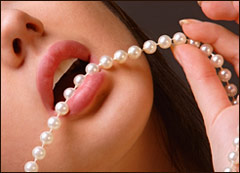Dear Umbra,
I’m nearly drowning in jewelry ideas for my valentine, but wary of mined gemstones. Do you know anything about the ecological impact of cultured pearls, or the faux “shell pearls”?
Swimming to the Surface Slowly
Portland, Ore.
Dearest SSS,
I apologize for missing your Valentine’s window, but you may have seen my wee notie regarding my inability to find pearls of wisdom on this topic. You would think I would just give up after fruitless searching and move on to researching a more pressing item, but nooooo. A little irritant got into my mantle with this pearly query, and I searched till I was nacred. Several readers wrote in with assistance: thank you Joyce, Blake, Jennifer, and Angie for scratching my itch. All for you, Mr. Jewelry — you and my bottomless pit of curiosity.
At the outset, we shall say that no worldwide pearl-production protest and eco-certification movement exists. Or, if they do, they need help with their publicity.
Pearls have their pros and cons. Pearl farms can be sustainable businesses with inherent vested interest in clean water environments. I’m sure many farms are irresponsible, as well. It is best to find a reputable jeweler who can tell you about the type of pearl, and where and how it was farmed. Helpful reader Joyce suggests starting with the reputable groups Gemological Institute of America, Jewelers of America, and American Gem Society.
Pearls are produced by mollusks, such as oysters, which have a one-piece body of muscle and goo. When a foreign irritant settles into a mollusk’s body, the mollusk coats it with aragonite and conchiolin, which together constitute the nacre, also known as mother of pearl. I don’t think you can make pearls with garden snails.
Today most commercially available pearls are “cultured,” that is, farmed — in either freshwater, in mussels, or saltwater, in oysters. One basic profile of a saltwater pearl oyster farm is one that grows its own oysters, suspends them in nets underwater, pulls them out to insert pearl starter material, then replaces the oyster in the water for a few years as it grows a little pearl. The insertion is interesting, and is how most cultured pearls are made. I read that the oyster can be numbed, by injection or dipping, to avoid shock. A small slit is made in the tissue, and two things are usually injected: foreign tissue from a proven sort of “master oyster” that helps the pearl form, and a pearl “nucleus” that is often shells of other mollusks formed into balls.
Obviously for the oysters this whole process is a mixed bag. They get to be alive, as any agricultural crop does, but only for a limited time and a specific purpose. An oyster may be used for several rounds of pearl production. For the natural environment it is also mixed. Before cultured pearls were common, the only way to get pearls was to open (and kill) oysters or mussels until you found enough pearls. That was hard on certain populations, we can be sure, and now that cultured pearls abound, natural pearls are very rare (and pricy).
Pearl farming today can be a sustainable aquaculture industry for small communities, a way to use marine or freshwater resources in a purposeful manner without devastating the ecosystem. Thanks to my informants, I was able to read quite a bit of literature about the benefits of a pearl industry in poorer countries where other small-scale industries have collapsed, such as the Solomon Islands. Pearls won’t form well in polluted or disturbed circumstances. People who may previously have been driven to destroy reefs, fisheries, and water purity on their way to make a living have an opportunity to maintain a clean, healthy water system for pearl farming. From what I read, sustainable pearl fisheries are being developed around the Pacific with assistance from development organizations.
Shell pearl, which you also mention, is formed differently. Manufacturers harvest oysters, cut the shells, and round them mechanically into pearly spheres. This appears to be similar to the method used to create the pearl nuclei for cultured pearls. Alas, Mr. Jewelry, my pearl information streak ran out once we got to shell pearls. They’re less expensive, and I assume the harvesters have less motivation to maintain a clean ocean, lake, or river over time, since they are killing the oysters to get their shells and may just move on to the next location once they’ve shucked the first dry. However, that is an assumption, not knowledge, and I must now take the nugget of information and go back into my underwater net, where I will spend three more years developing the next pearl of pearly wisdom.
Gastropodly,
Umbra


